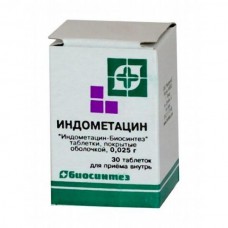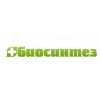Expiration date: 06/2026
Tablets
Action:
anti-inflammatory, analgesic, antipyretic.
Composition:
Indomethacin 25mg
Auxiliary substances: milk sugar, potato starch, MCC, powdered sugar, polyvinyl pyrrolidone, magnesium stearic, acetylcellulose, titanium dioxide, tween-80
Indications:
- articular syndrome
- pain in the spine, neuralgia, myalgia, rheumatism
- traumatic inflammation of soft tissue etc.
Suppositories
Clinico-pharmacological group
NSAIDs for topical application in ophthalmology
A drug with anti-inflammatory and angioprotective action for external use
NPVS
NSAIDs for external use
Pharmacological action
NSAIDs, a derivative endolysosomal acid. Anti-inflammatory, analgesic and antipyretic effect. The mechanism of action is associated with inhibition of the enzyme COX, which leads to the inhibition of synthesis of prostaglandins from arachidonic acid.
Inhibits platelet aggregation.
When administered orally or parenterally helps to reduce pain, especially joint pain at rest and in motion, reduces morning stiffness and swelling of joints, increase range of motion. Anti-inflammatory effect develops by the end of the first week of treatment.
The local application relieves pain, reduces swelling and erythema.
When used topically, in addition, helps to reduce morning stiffness, increase range of motion.
Pharmacokinetics
After intake of indomethacin is rapidly absorbed from the gastrointestinal tract. Cmax in plasma achieved through 2 h. Metabolized in the liver. Undergoes enterohepatic recirculation. Indomethacin is determined in the blood plasma in the form of unchanged substance and metabolites unrelated - detmering, dismantiling, desmethyl-desbenzoyl.
T1/2 is about 4.5 hours return with urine - 60% in the form of unchanged substance and metabolites and faeces - 33% mainly in the form of metabolites.
Indications
For systemic use: articular syndrome (W. rheumatoid arthritis, osteoarthritis, ankylosing spondylitis, gout), pain in the spine, neuralgia, myalgia, traumatic inflammation of soft tissues and joints, rheumatism, diffuse connective tissue disease, dysmenorrhea. As an adjuvant in infectious-inflammatory diseases of ENT-organs, adnexitis, prostatitis, cystitis.
For local use: prevention of the inflammatory process during surgery for cataract, and anterior segment of the eye, the inhibition of miosis during surgery.
For topical use: articular syndrome (W. rheumatoid arthritis, osteoarthritis, ankylosing spondylitis, gout), pain in the spine, neuralgia, myalgia, traumatic inflammation of soft tissues and joints.
Contraindications
Hypersensitivity to indomethacin, erosivno-azwenne shock syndrome in acute phase, "aspirin triad", a violation of hematopoiesis, severe liver and/or kidney disease, severe congestive heart failure, hypertension, pancreatitis, III trimester of pregnancy, children up to age 14 years, and for rectal use: proctitis, recent rectal bleeding.
Special instruction
Be used with caution in elderly patients and in diseases of the liver, kidneys, gastrointestinal tract in history, dyspeptic symptoms at the time of application, arterial hypertension, heart failure, immediately after major surgical interventions, parkinsonism, epilepsy.
When referring to a history of allergic reactions to NSAIDs are used only in emergency cases.
The treatment requires systematic monitoring of liver function and kidney picture of peripheral blood.
Not recommended simultaneous application with acetylsalicylic acid and other NSAIDs.
You should not use indomethacin simultaneously with diflunizalom.
While the use of indomethacin the drug lithium should be borne in mind the possibility of the onset of symptoms of the toxic effect of lithium.
The local application should not be applied on the wound surface of the skin, and avoid contact with eyes or mucous membranes.
Effects on ability to drive vehicles and management mechanisms
During treatment should refrain from potentially hazardous activities associated with the need to focus and increased speed of psychomotor reactions.
Dosage
Set individually depending on the severity of the disease. For adults the ingestion of the initial dose - 25 mg 2-3 times/day. When there is insufficient clinical effects, increase the dose to 50 mg 3 times/day. Dosage forms prolonged action apply 1-2 times/day. Maximum daily dose: 200 mg.
When the effect of treatment continued for 4 weeks in the same or a reduced dose. With prolonged use, the daily dose should not exceed 75 mg. after Taking food.
For the treatment of acute conditions or exacerbation of a chronic edema of give/m 60 mg 1-2 times/day. The duration of the/m introduction - 7-14 days. Then indomethacin administered orally or rectally 50-100 mg 2 times/day, the maximum daily dose should not exceed 200 mg. For maintenance treatment used rectally 50-100 mg 1 times/day at night.
For local use in ophthalmology dose, frequency and duration of application are determined individually.
Topically applied 2 times/day.
Drug interaction
While the use of indometacin may reduce effects of saluretikov, beta-blockers, potentiate the effects of anticoagulants.
With simultaneous use of indomethacin and diflunisal risk of bleeding from the gastrointestinal tract.
With simultaneous use with probenecid may increase the concentration of indomethacin in plasma.
Indometacin may decrease the tubular secretion of methotrexate, resulting in increased toxicity.
While the use of NSAIDs increases the toxicity of cyclosporine.
Indomethacin at a dose of 50 mg 3 times/day increases the concentration of lithium in the blood plasma and reduces the clearance of lithium from the body in patients with mental illness.
With simultaneous use of indomethacin and digoxin may increase the concentration of digoxin in plasma and increase in elimination half-life of digoxin.
Pregnancy and lactation
Indomethacin is contraindicated in the third trimester of pregnancy. In I and II trimestrah pregnancy and lactation (breastfeeding) not recommended.
Indomethacin in small amounts excreted in breast milk.
Side effect
From the digestive system: nausea, anorexia, vomiting, pain and discomfort in the abdomen, constipation or diarrhea, erosivno-azwenne defeat, bleeding and perforation of the gastrointestinal tract, rarely, intestinal stricture, stomatitis, gastritis, flatulence, bleeding from the sigmoid colon or from a diverticulum, jaundice, hepatitis.
CNS and peripheral nervous system: dizziness, headache, depression, fatigue, rarely - anxiety, syncope, drowsiness, convulsions, peripheral neuropathy, muscle weakness, involuntary muscle movements, sleep disorders, mental disorders (depersonalization, psychotic episodes), paresthesia, dysarthria, parkinsonism.
From the side of cardiovascular system: edema, increased blood pressure, tachycardia, chest pain, arrhythmia, palpitation, hypotension, congestive heart failure, hematuria.
Allergic reactions: rarely - itching, hives, angitis, erythema nodosum, skin rash, exfoliative dermatitis, Stevens-Johnson syndrome, erythema multiforme, toxic epidermal necrolysis, hair loss, acute respiratory distress, sudden drop in blood pressure, anaphylactic reaction, angioedema, dyspnoea, asthma, pulmonary edema.
With the hematopoietic system: rarely - leukopenia, petechiae or ekhimozy, purpura, aplastic and haemolytic anaemia, thrombocytopenia, DIC.
From the sensory organs: rarely - breach-definition of visual perception, diplopia, orbital and periorbital pain, tinnit, hearing loss, deafness.
From the urinary system: rarely - proteinuria, nephrotic syndrome, interstitial nephritis, renal dysfunction renal failure.
From the metabolic: rarely - hyperglycemia, glycosuria, hyperkalemia.
Other: rarely - vaginal bleeding, hot flashes, sweating, epistaxis, enlargement and tension of the mammary glands, gynecomastia.
Local reactions: in the ground/m introduction in some cases - the formation of infiltration, abscess, rectal use may result in irritation of the mucous membrane of the rectum, tenesmus, exacerbation of chronic colitis.
When applied externally: itching, redness, rash at the site of application.
Storage conditions
List B. In dry protected from light place, at temperatures below 25 °C



